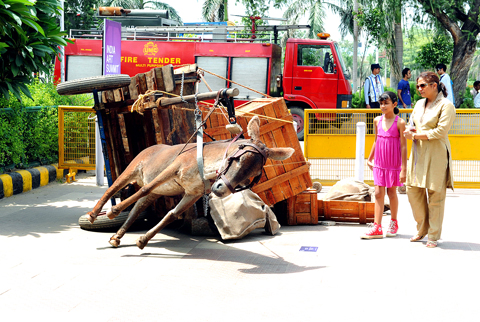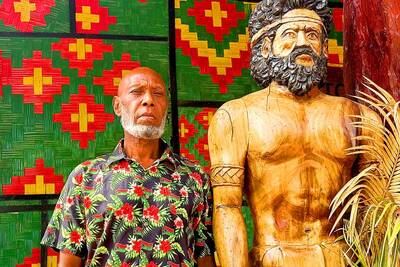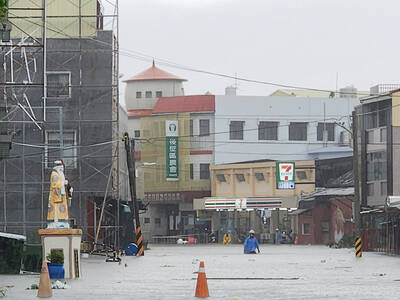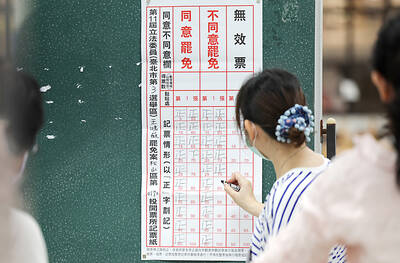For the past 20 years, Indian artists have had to watch in envy as foreign buyers showered recognition and cash on their Chinese peers.
But after years of institutional neglect, they finally seem to be getting the support they need to push their work on an international market that has traditionally focused on established artists in East Asia.
Last week saw the biggest-ever gathering of contemporary galleries in the country with the four-day India Art Summit, which aims to establish itself alongside other shows such as the now well-known Shanghai art fair.

PHOTO: AFP
“This is just the beginning. The summit is still growing, just like Indian contemporary art,” said Neha Kirpal, associate director of the event.
Like other experts, Kirpal concedes that China is “way ahead” of India in terms of the development of its art market.
Last year, the first edition of the summit had three international galleries. This year 17 participated despite the slowdown, Kirpal said.
But for Indian artists to reach a bigger audience, industry insiders say the supporting infrastructure must be improved — a common problem in all areas of life in India.
Art schools, galleries, museums and public funds are all lacking.
“Can anybody enlighten me about the government’s role in promoting art?” said Dadiba Pundole, owner of the Pundole art gallery in Mumbai, one of India’s oldest galleries. “They have failed miserably and it is only the private players that have kept the scene alive.”
There are just a handful of prominent galleries in India for thousands of artists and only a few crumbling museums, built between 1910 and 1920 by the British.
“The total number of art schools can be counted on one’s fingertips,” Kirpal said.
Yamini Mehta, director of modern and contemporary Indian art at the Christie’s auction house in London, says the Indian art business is gathering momentum, but the absence of institutional support is a problem.
“There has not been much institutional support and resources for the visual arts in India as there has been in China,” Mehta said.
She says the Chinese authorities have promoted the arts heavily since the 1980s to compensate for the loss of creativity during the Cultural Revolution of the 1960s.
Unlike Chinese art, much of the work by Indians is still bought by Indians, making the market inward-looking and limiting its development internationally.
“Most Indians buy indigenous works, which is a good way to start collecting art, but gradually Indian art has to step out of its own borders for wider acceptance,” said Stefan Wimmer from the Beck & Eggling art gallery in Germany, which had a display at the art summit.
The rise of India’s business elite is also creating a class of people ready to splash cash on domestic art, promising a brighter future for local artists.
“There are the fixed [established] clients and there are the new clients who have invested in houses, cars, jewelry but are looking for more. Art is their preferred choice,” says Shilpa Dugar of Krishala Arts, a gallery based in Chennai.
For now, prices for Indian art are off the highs reached in 2002 to last year, when international auction houses recorded record sales for the country’s celebrated artists M.F. Husain, F.N. Souza, S.H. Raza or Satish Gujaral. The market has fallen sharply, spelling bad news for some Indian galleries, particularly those that overstretched themselves during the boom years such as Bodhi, which has shut many of its international spaces.
“Indian art had become too pricey till last year. This year everyone is happy to reduce the prices by 25 to 30 percent,” an Indian art buyer who refused to be named told reporters.
Indian artists must also contend with constraints on their freedom of expression, a right guaranteed under the Indian Constitution but one that has been under attack from religious extremists.
The country’s most acclaimed painter was conspicuous by his absence at last week’s event because of fears for his security.
M.F. Husain, 94, has angered hardline Hindus by portraying Hindu deities in the nude or in a sexually suggestive manner, and his work and home have been attacked.

The paramount chief of a volcanic island in Vanuatu yesterday said that he was “very impressed” by a UN court’s declaration that countries must tackle climate change. Vanuatu spearheaded the legal case at the International Court of Justice in The Hague, Netherlands, which on Wednesday ruled that countries have a duty to protect against the threat of a warming planet. “I’m very impressed,” George Bumseng, the top chief of the Pacific archipelago’s island of Ambrym, told reporters in the capital, Port Vila. “We have been waiting for this decision for a long time because we have been victims of this climate change for

Rainfall is expected to become more widespread and persistent across central and southern Taiwan over the next few days, with the effects of the weather patterns becoming most prominent between last night and tomorrow, the Central Weather Administration (CWA) said yesterday. Independent meteorologist Daniel Wu (吳德榮) said that based on the latest forecast models of the combination of a low-pressure system and southwesterly winds, rainfall and flooding are expected to continue in central and southern Taiwan from today to Sunday. The CWA also warned of flash floods, thunder and lightning, and strong gusts in these areas, as well as landslides and fallen

MASSIVE LOSS: If the next recall votes also fail, it would signal that the administration of President William Lai would continue to face strong resistance within the legislature The results of recall votes yesterday dealt a blow to the Democratic Progressive Party’s (DPP) efforts to overturn the opposition-controlled legislature, as all 24 Chinese Nationalist Party (KMT) lawmakers survived the recall bids. Backed by President William Lai’s (賴清德) DPP, civic groups led the recall drive, seeking to remove 31 out of 39 KMT lawmakers from the 113-seat legislature, in which the KMT and the Taiwan People’s Party (TPP) together hold a majority with 62 seats, while the DPP holds 51 seats. The scale of the recall elections was unprecedented, with another seven KMT lawmakers facing similar votes on Aug. 23. For a

All 24 lawmakers of the main opposition Chinese Nationalists Party (KMT) on Saturday survived historical nationwide recall elections, ensuring that the KMT along with Taiwan People’s Party (TPP) lawmakers will maintain opposition control of the legislature. Recall votes against all 24 KMT lawmakers as well as Hsinchu Mayor Ann Kao (高虹安) and KMT legislative caucus whip Fu Kun-chi (傅崐萁) failed to pass, according to Central Election Commission (CEC) figures. In only six of the 24 recall votes did the ballots cast in favor of the recall even meet the threshold of 25 percent of eligible voters needed for the recall to pass,